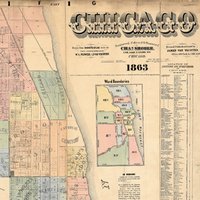
Sheet maps of Chicago from the 1860s, 1870s, and 1880s that are held at the University of Chicago Library's Map Collection. During these three decades, Chicago grew from a small city of 109,000 into a large one with a population of more than 1,000,000. It is often said that no city of the Western world had ever grown so quickly. Chicago's growth was in part associated with its status as the most important node in the American railroad system, which reached the Pacific in 1869. Industries prospered, particularly those involving the transformation of the raw materials of the West into products destined for the East. The Union Stockyards (1865), the South Works steel mills (1875), and the Pullman railway-car plant (early 1880s) were iconic examples. Growth was only barely interrupted by the catastrophic fire of 1871 in which perhaps a quarter of Chicago's dwellings and most of its business district were burned. The Fire did force the city to establish a new building code and perhaps encouraged a new self-consciousness about planning. The years after the Fire saw the implementation of the city's "boulevard" system and the inauguration of parks along the Lakefront of which Lincoln Park (institutionalized in 1864) is perhaps the best known example.
View Online Collection